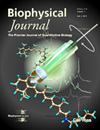Helical Sensors of Membrane Saturation: Changes in Orientation and Curvature Preference.
IF 3.1
3区 生物学
Q2 BIOPHYSICS
引用次数: 0
Abstract
The degree of unsaturation in lipids, which refers to the number of double bonds in their acyl chains, influences properties such as fluidity and lipid packing. However, it is not well understood how the unsaturation affects the ability of peptides to sense membrane curvature. In our study, we compared membranes with varying levels of unsaturation: mono-unsaturated POPC; bis-unsaturated DOPC; and poly-unsaturated PAPC. We investigated how these membranes interact with peptides of varying hydrophobicity. Using coarse-grained molecular dynamics simulations, we found that increasing unsaturation leads to deeper peptide insertion into the lipid bilayer, which correlates with a shift in curvature preference toward more negative values. We demonstrate that specific peptides preferentially localize on the positively curved regions in saturated membranes but shift preference to negatively curved regions in unsaturated membranes, thereby functioning as sensors of membrane unsaturation. In addition, polyunsaturated lipids facilitate the reorientation of peptides from a membrane-adsorbed state to a transmembrane state. These findings may play a role in biological processes such as vesicle formation, membrane fusion, and protein sorting, and highlight the adaptability of peptides to different lipid compositions in membranes.膜饱和的螺旋传感器:取向和曲率偏好的变化。
脂质的不饱和程度,指的是其酰基链中双键的数量,影响诸如流动性和脂质堆积等性质。然而,不饱和如何影响多肽感知膜曲率的能力还不是很清楚。在我们的研究中,我们比较了不同不饱和水平的膜:单不饱和POPC;bis-unsaturated DOPC;多不饱和PAPC。我们研究了这些膜如何与不同疏水性的肽相互作用。通过粗粒度的分子动力学模拟,我们发现不饱和度的增加导致更深的肽插入到脂质双分子层中,这与曲率偏好向负值的转变有关。我们证明了特定肽优先定位于饱和膜的正弯曲区域,但在不饱和膜中优先转移到负弯曲区域,从而作为膜不饱和的传感器。此外,多不饱和脂有助于多肽从膜吸附状态向跨膜状态的重新定向。这些发现可能在囊泡形成、膜融合和蛋白质分选等生物过程中发挥作用,并突出了肽对膜中不同脂质组成的适应性。
本文章由计算机程序翻译,如有差异,请以英文原文为准。
求助全文
约1分钟内获得全文
求助全文
来源期刊

Biophysical journal
生物-生物物理
CiteScore
6.10
自引率
5.90%
发文量
3090
审稿时长
2 months
期刊介绍:
BJ publishes original articles, letters, and perspectives on important problems in modern biophysics. The papers should be written so as to be of interest to a broad community of biophysicists. BJ welcomes experimental studies that employ quantitative physical approaches for the study of biological systems, including or spanning scales from molecule to whole organism. Experimental studies of a purely descriptive or phenomenological nature, with no theoretical or mechanistic underpinning, are not appropriate for publication in BJ. Theoretical studies should offer new insights into the understanding ofexperimental results or suggest new experimentally testable hypotheses. Articles reporting significant methodological or technological advances, which have potential to open new areas of biophysical investigation, are also suitable for publication in BJ. Papers describing improvements in accuracy or speed of existing methods or extra detail within methods described previously are not suitable for BJ.
 求助内容:
求助内容: 应助结果提醒方式:
应助结果提醒方式:


